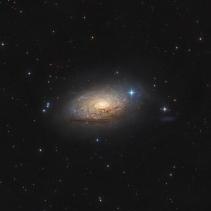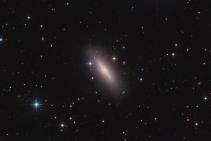Galaxies
M 63
Messier 63 (also known as M63, NGC 5055, or the Sunflower Galaxy) is a spiral galaxy in the constellation Canes Venatici consisting of a central disc surrounded by many short spiral arm segments. M63 is part of the M51 Group, a group of galaxies that also includes M51 (the 'Whirlpool Galaxy'). M63 is an active galaxy with a LINER nucleus.
M63 was discovered by Pierre Méchain on June 14, 1779. The galaxy was then listed by Charles Messier as object 63 in the Messier Catalogue.
In the mid-19th century, Lord Rosse identified spiral structures within the galaxy, making this one of the first galaxies in which such structure was identified.
In 1971, a supernova with a magnitude of 11.8 appeared in one of the arms of M63.
L = 12 * 1800 sec. bin1, RGB = 10 * 900 sec. bin2, HaOIII = 12 * 1800 sec. bin2.
Total time - 25.5 hours.
Pixinsight 1.8 and Adobe Lightroom.
M 102
Messier 102 (also known as M102) is a galaxy listed in the Messier Catalogue that has not been identified unambiguously. Its original discoverer Pierre Méchain later said that it was a duplicate observation of Messier 101, but there are historical and observational reasons to believe that it could be NGC 5866, although other galaxies have been suggested as possible identities.
L = 36 * 600 sec. bin1, RGB = 10 * 900 sec. bin2, HaOIII = 10*1800 sec. bin2, in the each filters.
Total exposition - 23.5 hours
Pixinsight 1.8, Photoshop.
NGC 4449
NGC 4449 (also known as Caldwell 21) is an irregular galaxy in the constellation Canes Venatici. It is located about 12 million light-years away, part of the M94 Group (the Canes Venatici I Group), a galaxy group relatively close to the Local Group containing the Milky Way.
L=6*1800 sec bin1, RGB=7*1200 sec bin2, HaOIII=14*1200 sec bin2.
Total time - 19 hours
Pixinsight 1.8, Lightroom.
M 100
Messier 100 (also known as NGC 4321) is an example of a grand design intermediate spiral galaxy located within the southern part of constellation Coma Berenices. It is one of the brightest and largest galaxies in the Virgo Cluster, located approximately 55 million light-years distant from Earth and has a diameter of 107,000 light years. It was discovered by Pierre Méchain on March 15, 1781 and was subsequently entered in Messier’s catalogue of nebulae and star clusters after Charles Messier made observations of his own on April 13, 1781. The galaxy was one of the first spiral galaxies to be discovered, and was listed as one of fourteen spiral nebulae by Lord William Parsons of Rosse in 1850. Two satellite galaxies named NGC 4323 -connected with M100 by a bridge of luminous matter- and NGC 4328 are present within this galaxy.
L = 15 * 1200 sec. bin1, RGB = 8 * 900 sec. bin2, in the each filters.
Total time - 11 hours
Pixinsight 1.8, Lightroom.




